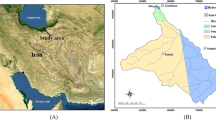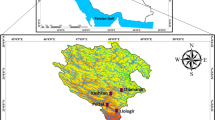Abstract
Accurate simulation of rainfall-runoff process is of great importance in hydrology and water resources management. Rainfall–runoff modeling is a non-linear process and highly affected by the inputs to the simulation model. In this study, three kinds of soft computing methods, namely artificial neural networks (ANNs), model tree (MT) and multivariate adaptive regression splines (MARS), have been employed and compared for rainfall-runoff process simulation. Moreover, this study investigates the effect of input size, including number of input variables and number of data time series on runoff simulation by the developed models. Inputs to the simulation models for calibration and validation purposes consist two parts: I1: five variables, including daily rainfall and runoff time series (30 years) with lag times, and I2: twelve variables, including daily rainfall and runoff time series (10 years). To increase the model performances, optimal number and type for input variables are identified. The efficiency of the training and testing performances using the ANNs, MT and MARS models is then evaluated using several evaluation criteria. To implement the methodology, Tajan catchment in the northern part of Iran is selected. Based on the results, it was found that using I1 as input to the developed models results in higher simulation performance. The results also provided evidence that MT (R = 0.897, RMSE = 6.70, RSE = 0.33) with set I2 is capable of reliable model for rainfall-runoff process compared with MARS (R = 0.892, RMSE = 7.47, RSE = 0.83) and ANNs (R = 0.884, RMSE = 7.40, RSE = 0.43) models. Therefore, size (length of data time series) and type of input variables have significant effects on the modeling results.












Similar content being viewed by others
References
Adamowski J, Chan HF, Prasher SO, Sharda VN (2012) Comparison of multivariate adaptive regression splines with coupled wavelet transform artificial neural networks for runoff forecasting in Himalayan micro-watersheds with limited data. J Hydroinf 14(3):731–744. doi:10.2166/hydro.2011.044
Adoko AC, Jiao YY, Wu L, Wang H, Wang ZH (2013) Predicting tunnel convergence using multivariate adaptive regression spline and artificial neural network. Tunn Undergr Space Technol 38:368–376. doi:10.1016/j.tust.2013.07.023
Asadi S, Shahrabi J, Abbaszadeh P, Tabanmehr S (2013) A new hybrid artificial neural networks for rainfall–runoff process modeling. Neurocomputing 121:470–480. doi:10.1016/j.neucom.2013.05.023
Bahat Y, Grodek T, Lekach J, Morin E (2009) Rainfall–runoff modeling in a small hyper-arid catchment. J Hydrol 373(1):204–217. doi:10.1016/j.jhydrol.2009.04.026
Bhattacharya B, Solomatine DP (2003) Neural networks and M5 model trees in modeling water level-discharge relationship for an Indian river. Eur Symp Artif Neural Netw Bruges (Belgium) 23-25:407–412
Buyukyildiz M, Tezel G, Yilmaz V (2014) Estimation of the change in lake water level by artificial intelligence methods. Water Resour Manag 28(13):4747–4763. doi:10.1007/s11269-014-0773-1
Chandwani V, Vyas SK, Agrawal V, Sharma G (2015) Soft computing approach for rainfall-runoff modelling: a review. Aquat Procedia 4:1054–1061. doi:10.1016/ j.aqpro.2015.02.133
Chen J, Adams BJ (2006) Integration of artificial neural networks with conceptual models in rainfall-runoff modeling. J Hydrol 318(1):232–249. doi:10.1016/ j.jhydrol.2005.06.017
Cheng MY, Cao MT (2014) Evolutionary multivariate adaptive regression splines for estimating shear strength in reinforced-concrete deep beams. Eng Appl Artif Intell 28:86–96. doi:10.1016/j.engappai.2013.11.001
Cheng CT, Ou CP, Chau KW (2002) Combining a fuzzy optimal model with a genetic algorithm to solve multi-objective rainfall–runoff model calibration. J Hydrol 268(1):72–86. doi:10.1016/S0022-1694(02)00122-1
Deo RC, Samui P, Kim D (2016) Estimation of monthly evaporative loss using relevance vector machine, extreme learning machine and multivariate adaptive regression spline models. Stoch Env Res Risk A 30(6):1769–1784. doi:10.1007/s00477-015-1153-y
Dorum A, Yarar A, Sevimli MF, Onüçyildiz M (2010) Modelling the rainfall–runoff data of susurluk basin. Expert Syst Appl 37(9):6587–6593. doi:10.1016/ j.eswa.2010.02.127
Etemad-Shahidi A, Mahjoobi J (2009) Comparison between M5′ model tree and neural networks for prediction of significant wave height in Lake superior. Ocean Eng 36(15):1175–1181. doi:10.1016/j.oceaneng.2009.08.008
Farfani HA, Behnamfar F, Fathollahi A (2015) Dynamic analysis of soil-structure interaction using the neural networks and the support vector machines. Expert Syst Appl 42(22):8971–8981. doi:10.1016/j.eswa.2015.07.053
Fischer MM (1998) Computational neural networks: a new paradigm for spatial analysis. Environment and Planning A 30(10):1873–1891. doi:10.1068/a301873
Friedman JH (1991) Multivariate adaptive regression splines. Ann Stat:1–67
Goyal MK, Ojha CSP (2010) Analysis of mean monthly rainfall runoff data of Indian catchments using dimensionless variables by neural network. J Environ Prot 1(2):155–171. doi:10.4236/jep.2010.12020
Goyal MK, Ojha CSP (2011) Estimation of scour downstream of a ski-jump bucket using support vector and M5 model tree. Water Resour Manag 25(9):2177–2195. doi:10.1007/s11269-011-9801-6
Hamidi O, Poorolajal J, Sadeghifar M, Abbasi H, Maryanaji Z, Faridi HR, Tapak L (2015) A comparative study of support vector machines and artificial neural networks for predicting precipitation in Iran. Theor Appl Climatol 119(3–4):723–731. doi:10.1007/s00704-014-1141-z
Hosseini SM, Mahjouri N (2016) Integrating support vector regression and a geomorphologic artificial neural network for daily rainfall-runoff modeling. Appl Soft Comput 38:329–345. doi:10.1016/j.asoc.2015.09.049
Jacquin AP, Shamseldin AY (2006) Development of rainfall–runoff models using Takagi–Sugeno fuzzy inference systems. J Hydrol 329(1):154–173. doi:10.1016/ j.jhydrol.2006.02.009
Jain P, Deo MC (2006) Neural networks in ocean engineering. Ships and Offshore Structures 1(1):25–35. doi:10.1533/saos.2004.0005
Kim S, Kim HS (2008a) Neural networks and genetic algorithm approach for nonlinear evaporation and evapotranspiration modeling. J Hydrol 351(3):299–317. doi:10.1016/j.jhydrol.2007.12.014
Kim S, Kim HS (2008b) Uncertainty reduction of flood stage forecasting using neural networks model. J Am Water Resour Assoc 44(1):148–165. doi:10.1111/j.1752-1688.2007.00144.x
Kim S, Singh VP (2013) Flood forecasting using neural computing techniques and conceptual class segregation. J Am Water Resour Assoc 49(6):1421–1435. doi:10.1111/jawr.12093
Kisi O (2015) Pan evaporation modeling using least square support vector machine, multivariate adaptive regression splines and M5 model tree. J Hydrol 528:312–320. doi:10.1016/j.jhydrol.2015.06.052
Kisi O, Parmar KS (2016) Application of least square support vector machine and multivariate adaptive regression spline models in long term prediction of river water pollution. J Hydrol 534:104–112. doi:10.1016/j.jhydrol.2015.12.014
Kisi O, Shiri J, Tombul M (2013) Modeling rainfall-runoff process using soft computing techniques. Comput Geosci 51:108–117. doi:10.1016/j.cageo.2012.07.001
Li Z, Huang G, Wang X, Han J, Fan Y (2016) Impacts of future climate change on river discharge based on hydrological inference: a case study of the Grand River watershed in Ontario, Canada. Sci Total Environ 548:198–210. doi:10.1016/ j.scitotenv.2016.01.002
McCandless TC, Haupt SE, Young GS (2015) A model tree approach to forecasting solar irradiance variability. Sol Energy 120:514–524. doi:10.1016/j.solener.2015.07.020
McCuen RH (1993) Microcomputer applications in statistical hydrology. Prentice Hall, Englewood Cliffs
Mengistu DT, Moges SA, Sorteberg A (2016) Revisiting systems type black-box rainfall-runoff models for flow forecasting application. Journal of Water Resource and Protection 8(1):65–83. doi:10.4236/jwarp.2016.81006
Najafzadeh M, Barani GA, Azamathulla HM (2014) Prediction of pipeline scour depth in clear-water and live-bed conditions using group method of data handling. Neural Comput & Applic 24(3–4):629–635. doi:10.1007/s00521-012-1258-x
Najafzadeh M, Rezaie Balf M, Rashedi E (2016) Prediction of maximum scour depth around piers with debris accumulation using EPR, MT, and GEP models. J Hydroinf 18(2):212. doi:10.2166/hydro.2016.212
Najafzadeh, M., Shiri, J., Rezaie-Balf, M. (2017). New expressions-based models to estimate scour depth at clear water conditions in rectangular channels. Mar Georesour Geotechnol, accepted DOI: 10.1080/1064119X.2017.1303009
Nourani V, Komasi M, Mano A (2009) A multivariate ANN-wavelet approach for rainfall–runoff modeling. Water Resour Manag 23(14):2877–2894. doi:10.1007/s11269-009-9414-5
Quinlan JR (1992) Learning with continuous classes. In: Adams, Sterling, editors. Proceedings of 5th Australian joint conference on artificial intelligence. World Scientific 92:343–348
Rahimikhoob A (2014) Comparison between M5 model tree and neural networks for estimating reference evapotranspiration in an arid environment. Water Resour Manag 28(3):657–669. doi:10.1007/s11269-013-0506-x
Rahimikhoob A (2016) Comparison of M5 model tree and artificial neural network’s methodologies in modelling daily reference evapotranspiration from NOAA satellite images. Water Resour Manag 30(9):3063–3075. doi:10.1007/s11269-016-1331-9
Rajurkar MP, Kothyari UC, Chaube UC (2004) Modeling of the daily rainfall-runoff relationship with artificial neural network. J Hydrol 285(1):96–113. doi:10.1016/j.jhydrol.2003.08.011
Rezaie-Balf M, Kisi O (2017) New formulation for forecasting streamflow: evolutionary polynomial regression vs. extreme learning machine. Hydrol Res:nh2017283. doi:10.2166/nh.2017.283
Riad S, Mania J, Bouchaou L, Najjar Y (2004) Rainfall-runoff model using an artificial neural network approach. Math Comput Model 40(7):839–846. doi:10.1016/j.mcm.2004.10.012
Samadi M, Jabbari E, Azamathulla HM, Mojallal M (2015) Estimation of scour depth below free overfall spillways using multivariate adaptive regression splines and artificial neural networks. Eng Appl Comput Fluid Mech 9(1):291–300. doi:10.1080/19942060.2015.1011826
Samui P (2013) Multivariate adaptive regression spline (MARS) for prediction of elastic modulus of jointed rock mass. Geotech Geol Eng 31(1):249–253. doi:10.1007/s10706-012-9584-4
Sattari MT, Pal M, Apaydin H, Ozturk F (2013) M5 model tree application in daily river flow forecasting in Sohu stream, Turkey. Water Resources 40(3):233–242. doi:10.1134/S0097807813030123
Sekulic S, Kowalski BR (1992) MARS: a tutorial. J Chemom 6(4):199–216. doi:10.1002/cem.1180060405
Seo Y, Kim S, Kisi O, Singh VP (2015) Daily water level forecasting using wavelet decomposition and artificial intelligence techniques. J Hydrol 520:224–243. doi:10.1016/j.jhydrol.2014.11.050
Setiono, Hadiani R (2015) Analysis of rainfall-runoff neuron input model with artificial neural network for simulation for availability of discharge at bah Bolon watershed. Procedia Engineering 125:150–157. doi:10.1016/j.proeng.2015.11.022
Sharda VN, Prasher SO, Patel RM, Ojasvi PR, Prakash C (2008) Performance of multivariate adaptive regression splines (MARS) in predicting runoff in mid-Himalayan micro-watersheds with limited data. Hydrol Sci J 53(6):1165–1175. doi:10.1623/hysj.53.6.1165
Shoaib M, Shamseldin AY, Melville BW (2014) Comparative study of different wavelet based neural network models for rainfall–runoff modeling. J Hydrol 515:47–58. doi:10.1016/j.jhydrol.2014.04.055
Singh KP, Basant A, Malik A, Jain G (2009) Artificial neural network modeling of the river water quality—a case study. Ecol Model 220(6):888–895. doi:10.1016/j.ecolmodel.2009.01.004
Singh VP, Jain SK, Tyagi A (2007) Risk and reliability analysis: a handbook for civil and environmental engineers. ASCE Press, Reston. doi:10.1061/9780784408919
Solomatine DP, Dulal KN (2003) Model trees as an alternative to neural networks in rainfall—runoff modelling. Hydrol Sci J 48(3):399–411. doi:10.1623/ hysj.48.3.399.45291
Solomatine DP, Xue Y (2004) M5 model trees and neural networks: application to flood forecasting in the upper reach of the Huai River in China. ASCE J Hydrol Eng 9(6):491–501. doi:10.1061/(ASCE)1084-0699(2004)9:6(491)
Sudheer KP, Gosain AK, Mohana Rangan D, Saheb SM (2002) Modelling evaporation using an artificial neural network algorithm. Hydrol Process 16(16):3189–3202. doi:10.1002/hyp.1096
Talei A, Chua LHC, Quek C (2010) A novel application of a neuro-fuzzy computational technique in event-based rainfall–runoff modeling. Expert Syst Appl 37(12):7456–7468. doi:10.1016/j.eswa.2010.04.015
Tokar AS, Johnson PA (1999) Rainfall-runoff modeling using artificial neural networks. ASCE J Hydrol Eng 4(3):232–239. doi:10.1061/(ASCE)1084-0699(1999)4:3(232)
Vafakhah M, Janizadeh S, Bozchaloei SK (2014) Application of several data-driven techniques for rainfall-runoff modeling. ECOPERSIA 2(1):455–469
Wang Y, Witten IH. (1997). Induction of model trees for predicting continuous classes. In: Proceedings of the poster papers of the European conference on machine learning
Wu CL, Chau KW (2011) Rainfall–runoff modeling using artificial neural network coupled with singular spectrum analysis. J Hydrol 399(3):394–409. doi:10.1016/ j.jhydrol.2011.01.017
Zahmatkesh Z, Burian SJ, Karamouz M, Tavakol-Davani H, Goharian E (2014a) Low-impact development practices to mitigate climate change effects on urban stormwater runoff: case study of new York City. ASCE J Irrig Drain Eng 141(1):04014043. doi:10.1061/(ASCE)IR.1943-4774.0000770
Zahmatkesh Z, Karamouz M, Goharian E, Burian SJ (2014b) Analysis of the effects of climate change on urban storm water runoff using statistically downscaled precipitation data and a change factor approach. ASCE J Hydrol Eng 20(7):05014022. doi:10.1061/(ASCE)HE.1943-5584.0001064
Zahmatkesh Z, Karamouz M, Nazif S (2015) Uncertainty based modeling of rainfall-runoff: combined differential evolution adaptive metropolis (DREAM) and K-means clustering. Adv Water Resour 83:405–420. doi:10.1016/j.advwatres.2015.06.012
Zeroual A, Meddi M, Assani AA (2016) Artificial neural network rainfall-discharge model assessment under rating curve uncertainty and monthly discharge volume predictions. Water Resour Manag 30(9):3191–3205. doi:10.1007/s11269-016-1340-8
Author information
Authors and Affiliations
Corresponding author
Rights and permissions
About this article
Cite this article
Rezaie-Balf, M., Zahmatkesh, Z. & Kim, S. Soft Computing Techniques for Rainfall-Runoff Simulation: Local Non–Parametric Paradigm vs. Model Classification Methods. Water Resour Manage 31, 3843–3865 (2017). https://doi.org/10.1007/s11269-017-1711-9
Received:
Accepted:
Published:
Issue Date:
DOI: https://doi.org/10.1007/s11269-017-1711-9




